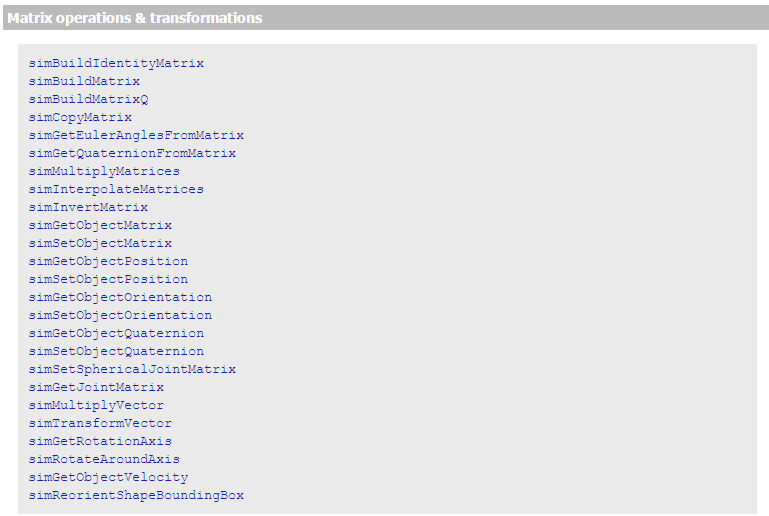VREP中的Regular API中有一些矩阵操作的函数,不过有时候还是不能满足计算需求,这时就需要在VREP中使用其它科学计算库(或者用Python/MATLAB之类的外部程序控制)。

在这里下载Lua Matrix,它是一个用纯Lua编写的矩阵运算库。解压后将lua文件夹中的matrix.lua和complex.lua复制到VREP安装目录下的lua文件夹中:
 下面是一个简单的测试,对矩阵进行一系列运算并验证。点击VREP仿真按钮,没有出现错误。
下面是一个简单的测试,对矩阵进行一系列运算并验证。点击VREP仿真按钮,没有出现错误。
if (sim_call_type==sim_childscriptcall_initialization) then local matrix = require "matrix" local mtx, m1,m2,m3,m4,m5, ms,ms1,ms2,ms3,ms4 -- normal matrix mtx = matrix {{1,2},{3,4}} assert( tostring(mtx) == "1 2 3 4" ) -- vector mtx = matrix {1,2,3} assert( tostring(mtx) == "1 2 3" ) -- matrix with size 2x2 mtx = matrix (2,2) assert( tostring(mtx) == "0 0 0 0" ) -- matrix with size 2x2 and default value 1/3 mtx = matrix (2,2,1/3) assert( tostring(mtx) == "0.33333333333333 0.33333333333333 0.33333333333333 0.33333333333333" ) -- identity matrix with size 2x2 mtx = matrix (2,"I") assert( tostring(mtx) == "1 0 0 1" ) -- matrix.add; number m1 = matrix{{8,4,1},{6,8,3}} m2 = matrix{{-8,1,3},{5,2,1}} assert(m1 + m2 == matrix{{0,5,4},{11,10,4}}, "error") -- matrix.sub; number m1 = matrix{{8,4,1},{6,8,3}} m2 = matrix{{-8,1,3},{5,2,1}} assert(m1 - m2 == matrix{{16,3,-2},{1,6,2}}) -- matrix.mul; number m1 = matrix{{8,4,1},{6,8,3}} m2 = matrix{{3,1},{2,5},{7,4}} assert(m1 * m2 == matrix{{39,32},{55,58}}) -- matrix.div; number m1 = matrix {{1,2},{3,4}} m2 = matrix {{4,5},{6,7}} assert( m1*m2^-1 == m1/m2 ) -- matrix.divnum; number, same complex m2 = matrix {{4,5},{6,7}} assert( m2/2 == matrix{{2,2.5},{3,3.5}} ) mtx = matrix {{3,5,1},{2,4,5},{1,2,2}} assert( 2 / mtx == matrix{{4,16,-42},{-2,-10,26},{0,2,-4}} ) -- matrix.det; number mtx = matrix {{1,4,3,2},{2,1,-1,-1},{-3,2,2,-2},{-1,-5,-4,1}} assert( mtx:det() == 78 ) -- matrix.invert; number mtx = matrix{{3,5,1},{2,4,5},{1,2,2}} local mtxinv = matrix{{2,8,-21},{-1,-5,13},{0,1,-2}} assert( mtx^-1 == mtxinv ) -- matrix.transpose mtx = matrix{{3,5,1},{2,4,5},{1,2,2}} assert(mtx^'T' == matrix{{3,2,1},{5,4,2},{1,5,2}}) end if (sim_call_type==sim_childscriptcall_actuation) then end if (sim_call_type==sim_childscriptcall_sensing) then end if (sim_call_type==sim_childscriptcall_cleanup) then end
Lua 模块与包
模块类似于一个封装库,从 Lua 5.1 开始,Lua 加入了标准的模块管理机制,可以把一些公用的代码放在一个文件里,以 API 接口的形式在其他地方调用,有利于代码的重用和降低代码耦合度。
Lua 的模块是由变量、函数等已知元素组成的 table,因此创建一个模块很简单,就是创建一个 table,然后把需要导出的常量、函数放入其中,最后返回这个 table 就行。以下为创建自定义模块 module.lua,文件代码格式如下:
-- 文件名为 module.lua -- 定义一个名为 module 的模块 module = {} -- 定义一个常量 module.constant = "这是一个常量" -- 定义一个函数 function module.func1() io.write("这是一个公有函数! ") end local function func2() print("这是一个私有函数!") end function module.func3() func2() end return module
由上可知,模块的结构就是一个 table 的结构,因此可以像操作调用 table 里的元素那样来操作调用模块里的常量或函数。
上面的 func2 声明为程序块的局部变量,即表示一个私有函数,因此是不能从外部访问模块里的这个私有函数,必须通过模块里的公有函数来调用.
require 函数
Lua提供了一个名为require的函数用来加载模块。要加载一个模块,只需要简单地调用就可以了。例如:
require("<模块名>")
或者
require "<模块名>"
执行 require 后会返回一个由模块常量或函数组成的 table,并且还会定义一个包含该 table 的全局变量。
-- test_module.lua 文件 -- module 模块为上文提到到 module.lua require("module") print(module.constant) module.func3()
以上代码执行结果为:
这是一个常量
这是一个私有函数!
或者给加载的模块定义一个别名变量,方便调用:
-- test_module2.lua 文件 -- module 模块为上文提到到 module.lua -- 别名变量 m local m = require("module") print(m.constant) m.func3()
以上代码执行结果为:
这是一个常量
这是一个私有函数!
参考: